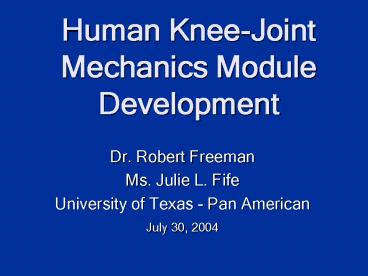Human KneeJoint Mechanics Module Development - PowerPoint PPT Presentation
1 / 13
Title:
Human KneeJoint Mechanics Module Development
Description:
Exercise 2: Draw a FBD of the Tibia for an isometric knee-extension exercise. ... Consider knee flexion during an isometric leg curl exercise. ... – PowerPoint PPT presentation
Number of Views:64
Avg rating:3.0/5.0
Title: Human KneeJoint Mechanics Module Development
1
Human Knee-Joint Mechanics Module Development
- Dr. Robert Freeman
- Ms. Julie L. Fife
- University of Texas - Pan American
- July 30, 2004
2
Project Goals
- To investigate the functional anatomy of the
- human knee using a number of distinct sagittal
- plane models
- Tibiofemoral Joint Variants
- Simple hinge joint model
- Cruciate linkage model
- Single-point surface contact model
- Patellofemoral Joint Variants
- Single-point patella model
- Rigid-body patella model
3
Challenge 1
Can voluntary contraction of the quadriceps
muscle group tear the ACL during an isometric
knee extension exercise?
4
Cruciate Linkage Model with Single-Point Patella
5
Working Model 2D Version of Cruciate Linkage Model
6
Exercises leading to Challenge 1
- Exercise 1 What "knee" muscles and ligaments are
active during Knee extension? - Consider only sagittal plane motion.
- Exercise 2 Draw a FBD of the Tibia for an
isometric knee-extension exercise. - Assume the ankle/foot is rigidly attached to the
tibia and that there is no friction between the
femoral condyles and the (flat) tibial plateau. - Exercise 3 Given the patellar-tendon force as a
function of the flexion angle FPT(q), compute the
force in the ACL as a function of flexion angle. - Given that the maximum force that the ACL can
withstand is 2000N, answer the challenge.
7
Challenge 2
- What constraint forces and moment are required to
keep the femur fixed during the isometric knee
extension exercise of challenge 1?
8
Challenge 3a
- Consider knee flexion during an isometric leg
curl exercise. - Develop an appropriate FBD and solution procedure
required to determine if you can voluntarily tear
either your ACL or PCL.
9
Challenge 3b
- Consider knee extension during an isometric
squat-to-stand exercise. - Develop an appropriate FBD and solution procedure
required to determine the maximum weight you can
squat.
10
Challenge 4
- Create your own WM2D Cruciate Linkage model of
the knee. - Follow the steps detailed in
- CruciateLinkDev.doc
- And the associated tutorial videos
11
Patellar Tendon Force
- The patellar tendon force (in Newtons) is given
below as the fifth order polynomial in the
flexion angle ? (in degrees). - This polynomial was obtained as an approximation
of the results given in Figure 6 of Serpas, et.al.
Fpt(?) 439.106 (305.71?1) (-18.185?2)
(0.554?3) (-6.674 x 10-3?4) (2.5x10-5?5)
12
(No Transcript)
13
(No Transcript)

